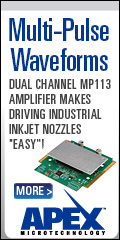 |
|
IN THIS ISSUE:
» Dealing With Nonlinear MOSFET Capacitances
» Building An Average Model For Primary-Side Regulated Flyback Converters
» A Practical Primer On Motor Drives (Part 14): Power Measurements On Distorted Signals
» Focus On Magnetics:
Eddy-Current Effects In Magnetic Design (Part 6): Winding Bundles
» Book Review:
Industry Pioneer Introduces Engineers To Broad Field Of Power Supply Design
» New Power Products
» In Memory Of Nathan Sokal
» Industry Event:
CMSE Continues To Tackle Component Challenges In Military & Space Electronics
» Other Top Power News
From the Editor's Desk David G. Morrison
Editor, HOW2POWER TODAY

In engineering, good ideas tend to come back in new forms. That’s true not only for design concepts but for other things as well. For example, the good idea that was the Unitrode and later TI power supply design seminars has sparked ongoing interest in articles and seminar notes that TI continues to offer on its website. This interest also inspired one of the key lecturers from this series, Bob Mammano, to write a book that pulls the seminar materials together into a unified and cohesive book. The result, Fundamentals of Power Supply Design, which Dennis Feucht has reviewed here in great detail, offers both a wide ranging introduction to the subject for newbies and a reference for experienced power supply designers. For those experienced designers, this issue also tackles a number of topics that may spark discussion or reflection. One is Sanjay Havanur’s article on MOSFET capacitances. As Havanur explains, improvements in MOSFET technology that have lowered on-resistance have also made the MOSFET’s capacitive characteristics highly nonlinear. In his article Havanur debunks some of the myths that have arisen to explain the nonlinearities and offers a refresher on the fundamentals that must be applied to deal with these nonlinearities. We also have Yann Vaquette’s feature on how to create an average model for primary-side-regulated flyback converters and design the compensation circuitry, Dennis Feucht’s final installment on eddy current losses and Ken Johnson’s feature on measuring power of distorted signals produced by motor drives. In addition, this issue includes a preview of the CMSE conference, a tribute to Nathan Sokal and more.
|
|
 |
 |

|
HOW2POWER EXCLUSIVE DESIGN ARTICLES 
|
Dealing With Nonlinear MOSFET Capacitances
by Sanjay Havanur, Vishay Siliconix, Santa Clara, Calif.
Two major developments in MOSFET technology that enabled improvements in on-resistance were the trench gate, and the charge balancing structures. Originally developed for high-voltage devices that resulted in superjunction MOSFETs, charge balancing is now getting extended to lower voltages as well. While it reduces both RDSON and all the junction capacitances dramatically, charge balancing makes the latter much more nonlinear. The effective stored charge and energy in the MOSFET is indeed reduced, and significantly so, but calculating these parameters or comparing different MOSFETs for optimum performance has become a rather complicated exercise. As a result, the conventional approach to understanding MOSFET parameters such as COSS and CRSS is no longer valid. This article explains why and presents some guidance on how to better evaluate a MOSFET’s performance within its operating envirobnment based on principles of stored charge and energy.
Read the full story…
|

Comparing capacitances for planar versus
superjunction MOSFETs with similar RDSON. |

|

Simplified schematic of a
PSR-based flyback structure. |
Building An Average Model For Primary-Side Regulated Flyback Converters
by Yann Vaquette, ON Semiconductor, Toulouse, France
Primary-side-regulated (PSR) controllers can reduce the size and cost of flyback-based ac-dc adapters by simplifying the feedback chain. These controllers are now found in a variety of applications and compete against existing optocoupler-based designs. This article will describe the main differences between a classical flyback converter with optocoupler and a PSR flyback. Then we will see how we can build an average model for the PSR flyback—one that includes a sample-and-hold network—and simplify it without impacting the transfer function. The transfer function will be evaluated and results obtained with Mathcad plots of the transfer function will be compared with simulations of the converter. Finally, the loop compensation will be plotted and calculations needed to adjust the phase margin detailed. Read the full story…
|

A Practical Primer On Motor Drives (Part 14): Power Measurements On Distorted Signals
by Ken Johnson, Teledyne LeCroy, Chestnut Ridge, N.Y.
Power conversion systems and drives do not output sinusoidal signals—they are PWM signals and they have high harmonic content. This high harmonic content can be thought of as a multi-vector system, with one rotating voltage vector and one rotating current vector (for each phase) for “N” harmonics, with each voltage and current vector system associated with a given harmonic having a unique phase angle. We cannot directly measure the phase angle between distorted voltage and current waveforms. We must use a digitally sampled waveform technique, as described previously, for accurate calculation of the power values for these waveforms. In this part we will discuss some additional considerations such as advanced cyclic period detection and display, harmonic filtering of power measurements, and the impact of line-to-reference voltage probing, which will aid in correct measurement of power.
Read the article…
|

A single line-to-line voltage and
line-current
output of a low-voltage
vector FOC drive. The filtered Sync
signal with cyclic period overlays
is also shown (upper right.) |

 |  |

FOCUS ON MAGNETICS 
Sponsored by Payton Planar Magnetics
A monthly column presenting information on power magnetics design, products, or related technology |

Eddy-Current Effects In Magnetic Design (Part 6): Winding Bundles
by Dennis Feucht, Innovatia Laboratories, Cayo, Belize
This article series closes with an additional design consideration when multistrand windings or bundles are used to reduce winding resistance because of eddy-current effects. Strands have an equivalent number of layers within a bundle and the layer value for use in the Dowell formula (and graphs) of the previous part 5 can be approximated from the number of strands with the same current polarity. This part derives the formula for that approximation, which allows calculation of the layer value, M, from parameters such as number of strands, strands per layer, and strand packing factor. Then, we delve into eddy current effects encountered in the special case of unibundle construction where primary and secondary strands are all twisted in the same bundle. Read the full story…
|

 |
 |

BOOK REVIEW  |
|
Industry Pioneer Introduces Engineers To Broad Field Of Power Supply Design
Fundamentals of Power Supply Design, Robert A. Mammano, First edition, Texas Instruments, 2017, 333 numbered pages, ISBN: 978-0-9985994-0-3.
Reviewed by Dennis Feucht, Innovatia Laboratories, Cayo, Belize
When I dove into this book by Bob Mammano, a leading figure in the development of power conversion, I could tell from the topics in the table of contents that it would be an interesting read. This is an industry- and design-oriented book. So what is a power supply? The second sentence of chapter 1 sets the tone (p. 1): [From] the average electronic-system designer, you may well get the answer: “A power supply is an abomination that takes up too much space in my enclosure, uses up some of my available power, heats up my sensitive circuitry, and blows a hole in my budget!” The challenge of power-supply design is thereby made direct and obvious. Bob Mammano’s depth of experience begins to come through immediately.
Read the full story…
|
 |

 |
|
|

 — POWER PRODUCTS IN 3 IMAGES OR LESS — POWER PRODUCTS IN 3 IMAGES OR LESS 
|


Dialog Semiconductor’s DA9313
switched-capacitor dc-dc converter. |
Inductorless Converter Delivers 10 A With Over 98% Efficiency
 Diagram: The DA9313 switched-capacitor dc-dc converter delivers up to 10 A or 50 Wpk of unregulated output at 1/2 VIN while operating from a 5 to 10.5-V input. Diagram: The DA9313 switched-capacitor dc-dc converter delivers up to 10 A or 50 Wpk of unregulated output at 1/2 VIN while operating from a 5 to 10.5-V input.
 Graph: Operating from a 7.4-V input, the dc-dc converter achieves percentage efficiencies in the high 90s across most of the load range. Graph: Operating from a 7.4-V input, the dc-dc converter achieves percentage efficiencies in the high 90s across most of the load range.
 Graph: Though the DA9313 is described as unregulated, it achieves reasonably flat load regulation over a good portion of its load range. Graph: Though the DA9313 is described as unregulated, it achieves reasonably flat load regulation over a good portion of its load range.
More details… |



Vicor’s PI3525-00-LGIZ 48-V
Cool-Power ZVS buck regulator. |
48-V Buck Regulator Delivers 20 A In Less Than 740-mm2 Footprint
 Photo: Housed in a 10-mm x 14-mm LGA SiP package, the PI3525-00-LGIZ buck regulator converts a 48-V input to 5-V output while supplying up to 20 A. The regulator requires only an output inductor and minimal passives for a complete cost-effective design that consumes less than 740 mm2 of PCB real estate. Up to three devices can be paralleled to deliver higher output currents. Photo: Housed in a 10-mm x 14-mm LGA SiP package, the PI3525-00-LGIZ buck regulator converts a 48-V input to 5-V output while supplying up to 20 A. The regulator requires only an output inductor and minimal passives for a complete cost-effective design that consumes less than 740 mm2 of PCB real estate. Up to three devices can be paralleled to deliver higher output currents.
More details… |

STMicroelectronics’ MDmesh
K5 superjunction MOSFETs. |
900-V MOSFETs Enhance Power And Efficiency Of Flyback Converters
 Photo: The 900-V MDmesh K5 super-junction MOSFETs are said to be the first 900-V MOSFETs with on-resistance below 100 mΩ and the best on-resistance among DPAK devices. Also, claiming the lowest gate charge, these devices promise faster switching for greater flexibility where a wide input-voltage range is required. Photo: The 900-V MDmesh K5 super-junction MOSFETs are said to be the first 900-V MOSFETs with on-resistance below 100 mΩ and the best on-resistance among DPAK devices. Also, claiming the lowest gate charge, these devices promise faster switching for greater flexibility where a wide input-voltage range is required.
More details… |


|
MORE POWER TECHNOLOGY NEWS:
• Power Electronics Roadmap Charts Path For U.S. Manufacturers More details…
|


IN MEMORY OF…  |
|
Longtime consultant and industry pioneer, Nathan Sokal passed away last May. Among his many accomplishments Nat is best known for his invention, together with his son Alan, of the Class E amplifier. Over the years, this invention has found use in numerous applications in both RF power generation and dc-dc power conversion. Nat was admired and respected by many in the RF and power electronics fields. In this issue, we share Nat’s talk on how he and his son developed the Class E amplifier and a short bio of his life.
 "The Origin and Development Of the High-Efficiency Class-E RF Power Amplifier" "The Origin and Development Of the High-Efficiency Class-E RF Power Amplifier"
by Nat Sokal
 Nathan Sokal’s story Nathan Sokal’s story
On June 8, Nat will be honored by members of the RF and microwave community with a special/memorial session on "Nathan Sokal and the Class E amplifier" at the International Microwave Symposium in Honolulu. For more information, email Fritz Raab.
|

|










|

INDUSTRY EVENTS  |

CMSE Continues To Tackle Component Challenges In Military & Space Electronics by Tom Terlizzi, CMSE 2017 Exhibits Chairman and Member Of the Program Committee
For over 20 years, the Components for Military and Space Electronics (CMSE) conference has provided valuable information on electronic component technology selection, improved testing and controls to assure reliability in military applications, and solutions for obsolete component issues. This event provides needed training and serves as a forum to address issues between the manufacturers and the military and space users of components. Over the years CMSE has covered all types of components with concentration on semiconductors and passives. This year’s conference, CMSE 2017, will run April 11–13, 2017 at the Sheraton Four Points Hotel at Los Angeles airport (LAX). The CMSE 2017 technical program will continue to build on its heritage but expand into other critical technical areas including hermetic and non-hermetic packaging technology and testing issues and copper wire for microelectronic assembly.
Read the full story…
|


OTHER TOP POWER NEWS
|
|
 The PSMA Magnetics Committee and IEEE PELS will hold the second workshop “Power Magnetics @ High Frequency: Transforming the Black Magic to Engineering” on Saturday, March 25, 2017—the day before and in the same venue as APEC 2017 at the Tampa Convention Center in Tampa, FL. The PSMA Magnetics Committee and IEEE PELS will hold the second workshop “Power Magnetics @ High Frequency: Transforming the Black Magic to Engineering” on Saturday, March 25, 2017—the day before and in the same venue as APEC 2017 at the Tampa Convention Center in Tampa, FL.
 Dushan Boroyevich, National Academy of Engineering member and co-director of the Center for Power Electronics Systems (CPES) will lead an Energy Innovation Initiative, which is part of a broader push to expand the scope and impact of Virginia Tech’s discoveries and to deepen the university’s research partnerships with leading companies. Dushan Boroyevich, National Academy of Engineering member and co-director of the Center for Power Electronics Systems (CPES) will lead an Energy Innovation Initiative, which is part of a broader push to expand the scope and impact of Virginia Tech’s discoveries and to deepen the university’s research partnerships with leading companies.
 General Atomics Electromagnetic Systems has developed a High Energy Pulsed Power Container (HEPPC) that pthat provides twice the energy density of existing railgun pulsed power solutions, reducing the number of containers required to launch projectiles or hybrid missiles from a railgun weapon system. General Atomics Electromagnetic Systems has developed a High Energy Pulsed Power Container (HEPPC) that pthat provides twice the energy density of existing railgun pulsed power solutions, reducing the number of containers required to launch projectiles or hybrid missiles from a railgun weapon system.
 Renesas Electronics, a supplier of advanced semiconductor solutions, and Intersil, a provider of innovative power management and precision analog solutions, have announced the completion of Renesas’ acquisition of Intersil. The transaction brings together the advanced technology and deep end-market expertise of the two companies, and solidifies Renesas’ position as a global supplier of advanced embedded systems. Renesas Electronics, a supplier of advanced semiconductor solutions, and Intersil, a provider of innovative power management and precision analog solutions, have announced the completion of Renesas’ acquisition of Intersil. The transaction brings together the advanced technology and deep end-market expertise of the two companies, and solidifies Renesas’ position as a global supplier of advanced embedded systems.
 Power semiconductor solutions company Semitrex has rebranded and changed its name to Helix Semiconductors. Power semiconductor solutions company Semitrex has rebranded and changed its name to Helix Semiconductors.
 A new report examines the role of engineering technology, calls for increased awareness of field of study and employment. A new report examines the role of engineering technology, calls for increased awareness of field of study and employment.
|

 |
 |

|
